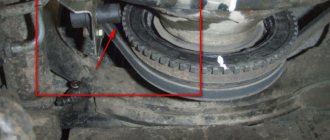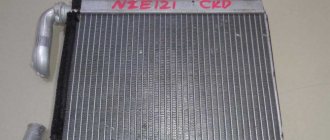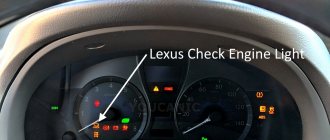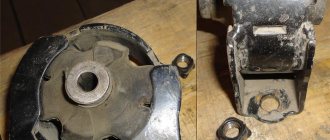The translation of the expression “check engine” in Russian literally sounds like “check the engine.” The “check” icon is on the dashboard of most modern cars, but its meaning remains unclear to many. Therefore, if this icon is yellow or orange engine icon - appears and does not disappear (or simply blinks), an inexperienced driver has a natural question: “what does this mean?” Next, we’ll try to find out the reasons why the check engine light came on on the dashboard of your car, as well as how to get rid of it.
Initially, this light indicated problems with the carburetor, but now that cars are equipped with full-fledged on-board computers, the message may indicate various malfunctions. For example, a “check engine” error may indicate problems with the quality of the air-fuel mixture or ignition faults, as well as many other things. Messages can be caused by both minor and critical failures.
Thus, when the “check engine” light is on, it is only clear that the ECU has detected a malfunction in one of the car’s systems. Only diagnostics can give a complete picture. Next, we will look at the main reasons why the check engine light is on and what needs to be done about it.
TOP 10 reasons why the check engine light came on
- The fuel tank cap is open . Check if it is closed tightly.
- Bad gasoline . The system can respond to fuel quality. The solution would be to drain the gasoline and fill it with better quality.
- Oil level . First of all, check its level with a dipstick. Also look for cracks in the block and oil leaks.
- Problems with the fuel pump or strainer in the tank. Check that the pump runs smoothly and does not make any unusual sounds.
- Dirty injectors . Eliminated by cleaning the injectors.
- Faulty high voltage wires or coils.
- Problem with spark plugs . The icon also lights up if there are problems with the spark plugs. It is worth checking the performance of the spark plugs and, if necessary, replacing them.
- No spark in one of the cylinders.
- The lambda probe is faulty . The problem can only be eliminated by replacing this unit with a new one or installing a blende; occasionally cleaning helps.
- Catalyst failure . Also solved by replacing the catalyst.
Only the main reasons and ways to solve them are listed here. In fact, there are many more of them. Diagnostics of the on-board computer, which controls all vehicle systems, can give a more complete picture of the current situation.
Check engine is not hidden on the dashboard of the Madza CX-5
Check engine on the Peugeot Partner panel is hiding in the left corner
The most common 5 reasons for the error
The most common problems when this error occurs are:
- Oxygen sensor malfunction;
- The fuel filler cap is not tightly closed;
- Failure of the exhaust gas catalyst;
- Malfunction of the mass air flow sensor;
- Faulty spark plugs or high-voltage wires.
Let's look at each of the reasons in a little more detail. The oxygen sensor is part of the system that processes exhaust gases. This sensor helps control fuel consumption. A malfunction of this sensor is taken as an engine malfunction. That is, the system cannot accurately calculate the fuel supply level and this is precisely why the error occurs. Most Corolla models have from 2 to 4 such sensors, so we should know that an error due to them is possible.
The next option is a loosely sealed fuel tank. On the tank neck of any modern car there is a sensor that is responsible for the tightness of its closure. So if the neck is not closed tightly, the car's computer accepts this as an engine error. Therefore, before suffering from a malfunction, it is worth checking the cover.
The third option may be an exhaust gas catalyst. When it becomes unusable, the car's engine loses its power and due to this, the car's computer may also show an error, since loss of power is a good reason for turning on the error. Loss means some kind of malfunction.
The air flow sensor regulates the amount of air supplied to the fuel for further launch into the engine cylinders. A faulty air supply sensor can lead to an increase in fuel consumption, as well as a decrease in engine power, so the on-board computer may consider this malfunction as an engine error.
Failed spark plugs can also be one of the causes of engine malfunction. The process of incorrect ignition in the engine cylinders usually leads to an error that is generated by the computer. Replacing the spark plugs or adjusting them can correct the problem and eliminate the computer error.
These are the main reasons why the “Check engine” or “Check engine” error appears on a Toyota Corolla. However, to more accurately clarify the problem, we can use self-diagnosis.
How to remove check engine
Let's take a closer look at the steps that need to be taken first of all in order to get rid of the Check Engine indicator that lights up. The priority action algorithm will be as follows:
- Check if the gas tank cap is closed . The situation is especially relevant if you have just left the gas station, and soon after that the check engine icon comes on. This means that either the tightness of the fuel system has been broken due to the tank cap not being screwed tightly enough, or the quality of the fuel leaves much to be desired.
- Check the condition of the spark plugs . To do this, unscrew them and visually assess their condition. Very often, it is the spark plugs that cause the Check Engine light to come on. In particular, the reason may be that they begin to pass current due to carbon deposits on the electrodes. This coating is formed as a result of the high content of metals or other conductive substances in the fuel. An error may also occur if the gap between the electrodes on the spark plug exceeds a distance of 1.3 mm. We will look separately at diagnosing candles and how to do it based on their color. You will also find information about replacing them useful.
- Oil level. If the check engine light only lights up when the engine warms up, stop and listen, you may hear extraneous sounds from the engine. Check the engine oil level with a dipstick and add it if necessary. Also check for oil leaks.
- If your car is equipped with sensors for the purity of process fluids (motor oil, fuel, etc.), then the indicator may light up if the corresponding indicators exceed the permissible limit . The solution is to replace the appropriate filters or completely liquids if they do not meet the standards.
- Resetting the negative terminal from the battery ( 15...20 seconds ). After this, the Check Engine light should go out and the clock on the computer should reset to zero. This method may be relevant in two cases. The first is a banal “glitch” of the ECU. The second is if a large number of small errors have accumulated in the memory of the electronic unit and have not been reset. (usually they are caused by the use of low-quality gasoline, the presence of harmful impurities in the fuel-air mixture, moisture on electrical contacts, etc.).
The most convenient way is not to reset the terminal, as all settings in the car are reset, but to use a multi-brand scanner, such as Rokodil ScanX
.
After all, this is an inexpensive option that is compatible with 99% of cars manufactured in 1993, and it also fully supports all the functionality of popular diagnostic programs for smartphones. Whatever block there is an error in, you will not only reset it, but also see approximately the reason for the occurrence. If, after performing the above steps, the Check Engine indicator does not go out, or goes out, but soon lights up again, this means that the error lies deeper, and in order to eliminate it, additional detailed diagnostics must be carried out using more serious means.
The check engine light is on - what should I do next?
You can try to find out the reason yourself by counting the number of blinks of the “check” and check the technical documentation for the designation of such an error code. For different cars there are different intervals between flashes and different codes by which they are interpreted.
Most of the errors that the indicator tells you about are not critical . You can perform diagnostics in two ways - yourself and by visiting a service station. The fact is that to obtain information in this case, you need special equipment or at least software for a smartphone.
But first of all, you need to find out how the car’s behavior changed after the error appeared. This is done in order to determine whether it is possible to drive with the check engine light on the panel, or whether it is better not to do this so as not to aggravate the problem.
| Car behavior | Icon is lit continuously | The check is blinking |
| No changes in car behavior | Movement Can continue | NOT continue driving |
The car suddenly changed its behavior:
| IT IS FORBIDDEN keep moving | IT IS FORBIDDEN keep moving |
| Engine power and throttle response remain the same | Can keep moving | Can keep moving |
| The engine has become less responsive, the speed does not rise above a certain value (engine operation in emergency mode) | You can continue moving | The movement cannot be continued |
| No additional warning lights came on on the instrument panel. | Can drive | You can go |
Along with the check engine icon, another indicator came on:
| Movement IT IS FORBIDDEN continue | Movement IT IS FORBIDDEN continue |
When does the check engine light come on?
We find out the reason why the check light is on
The error code can be read using a laptop with special software. The computer is connected via a cable to the machine's ECU and diagnostics are carried out. Also, using a laptop, you can enter additional external commands into the control unit or correct (reset) errors that appear.
A simpler method is to download an ECU communication and analytics program to your Android smartphone (for example, TORQUE, it has free and paid versions). And a Bluetooth adapter (car scanner) is connected to the electronic unit, which allows you to read information from the device. If you don’t have a laptop or you simply don’t want to bother installing additional software, you can delegate the described procedures to service station workers. They have all the necessary equipment and programs.
It must be remembered that each car (and sometimes each ECU on the same cars, but different years of manufacture) has a different list of error codes . Therefore, after receiving the information, you must have a standard set of diagnostic error codes (Diagnostic Trouble Code - DTC). You can find it in additional literature on diagnostics or on the Internet (for example, on thematic forums dedicated to your car model).
Another common cause for injection engines is problems with the injectors. In particular, the appearance of a significant amount of sediment on them. The solution to this problem is to clean the injectors. If problems occur with spark plugs, injectors, or the activated check engine indicator, the following symptoms may occur:
- weak engine thrust;
- high fuel consumption;
- jerks when accelerating or unstable operation of the engine;
- “floating” engine speed at idle.
The next step is to check the pressure in the fuel system. To do this you need to use a pressure gauge. The standard pressure for most non-tuned cars is 3 atmospheres (kgf/cm2). However, check this information in the registration certificate of your car. If the pressure is significantly lower, then the problem may lie in a faulty fuel pump or dirty injectors. If the pressure is constantly low, check the fuel pump. If at first it is normal, but drops shortly after starting the engine, check the injectors. Also pay attention to the mesh in the gas tank.
It is also worth checking the insulation of high voltage wires . It is better to do this not visually, but using a tester turned on in ohmmeter mode. wire insulation value at least 0.5 MOhm . Otherwise, the wire must be replaced.
If the Check Engine light comes on after you turn the key, and then goes off a few seconds later, this means that the system is performing a self-diagnosis and there is no cause for concern.
How to get to the service station when the Check Engine light is on
When driving to a service station, try to maintain a gentle driving regime. In particular:
- do not exceed speed more than 60 km/h;
- do not exceed engine speed more than 2500 rpm;
- turn off the air conditioner (heater), multimedia system and other currently unnecessary equipment that creates additional load on the engine;
- Avoid sudden starts and braking, drive smoothly.
You can return to normal driving only after diagnosing and eliminating the identified errors.
What to do if the check engine light comes on
In some cases, it is impossible to figure out what a lit emergency symbol means without analyzing the self-diagnosis codes embedded in the on-board computer. It is important for the driver to know why the check light is on and how urgently the power plant needs to be repaired. In case of some malfunctions, you can drive to the repair service yourself. In case of complex breakdowns, it is necessary to call a tow truck.
Table: Common Error Codes
Directories of self-diagnosis codes for foreign cars consist of multi-page descriptions. The main alphanumeric self-diagnosis code can be accompanied by a short description in English or Russian by the on-board computer. Since English-language terms are incomprehensible to many drivers, we present the main codes that accompany the illuminated check engine light, with a description in Russian.
| Codes | Description |
| P0100 | Failure of the air flow sensor (or circuit) |
| P0105, P0106 | Air pressure sensor signal abnormalities (may be associated with an open gas tank cap) |
| P0125 | Cooling faults |
| P0130 – P0140 | Incorrect signals, reading failures, lambda probe breaks |
| P0195, P0199 | Failures, signal violations of the oil temperature sensor |
| P0200 | Injector control circuit malfunctions |
| P0201 – P0212 | Defects in injectors by cylinder |
| P0230 – P0233 | Violations of the primary and secondary circuits of the fuel pump |
| P0300 | Misfires |
| P0301 – P0312 | Misfire (by cylinder) |
| P0321 – P0323 | Violations, omissions of ignition distribution signals |
| P0350 – P0362 | Ignition coil malfunctions |
| P0400 – P0402 | The exhaust gas recirculation system does not work |
| P0420 – P0434 | Catalyst malfunctions |
| P0561 | On-board voltage instability |
| P0600 – P0606 | Electronic control unit module errors |
| P1604 | Engine starting system failures |
| P1398 | Crankshaft position sensor failure |
| P1120 – P1125 | Violations of signals from the throttle valve |
| P1605 – P1620 | Flash Memory Failures |
For budget foreign cars, simultaneously with the check engine light coming on, the computer can display general error descriptions , such as “power is limited”, “maintenance is due”. In such situations, it is difficult to analyze the exact cause of the signal. The best solution would be to visit a car service center for a full computer diagnostic of the internal combustion engine.
How to get to a service station if the Check Engine light is on
In practice, if the check is flashing, this is due to a serious malfunction. It is impossible to continue driving with malfunctions of the crankshaft sensor, electrical wiring, oil starvation of the cylinders, a burning smell, floating speed or vibrations of the internal combustion engine.
Driving with clogged injectors ; operation with incorrect injection leads to the destruction of pistons, oil pans, and piston rings. In such cases, it is necessary to call a tow truck.
In what cases can you get to the service station yourself?
Experienced drivers and auto mechanics believe that you can drive to a service station under your own power in the following cases:
- after refueling with low-quality fuel;
- in case of breakdown of the mass air flow sensor;
- with a slight drop in power;
- when the message “Maintenance is due” appears.
In any case, driving with the check engine light on requires constant monitoring of the coolant temperature and oil level.
You need to go to the repair service at low speed. Be sure to ensure that the engine speed does not exceed 3000. It is recommended to drive smoothly, without sudden acceleration or braking. To facilitate the operation of electronics, you can turn off the radio (or media system) and turn off the air conditioning.









